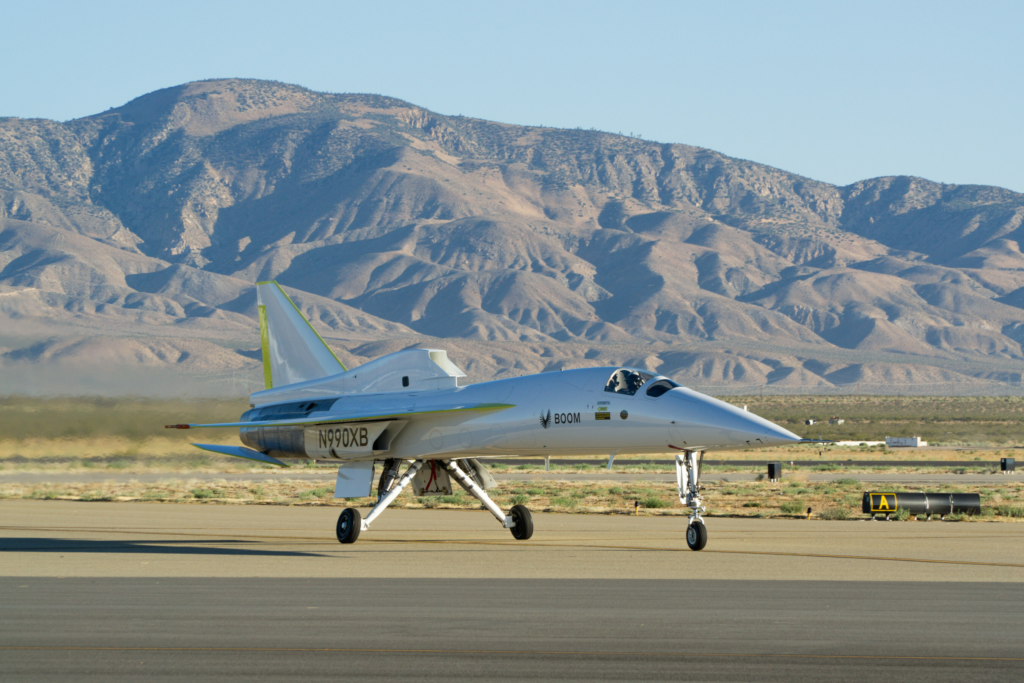DENVER- Boom Supersonic, the pioneering entity behind the creation of the world’s swiftest commercial aircraft, Overture, has revealed the successful attainment of several pivotal achievements in the development of its technology demonstrator aircraft, XB-1.
This milestone underscores Boom’s adeptness in harnessing over six decades of advancements in aviation technologies, such as carbon fiber composites, cutting-edge avionics, and digitally-refined aerodynamics.
The outcome is a platform that lays the groundwork for ecologically viable supersonic travel.

Boom Supersonic XB-1 Milestone
In the earlier months of this year, XB-1 was relocated from Boom Supersonic’s hangar in Centennial, Colorado, to the Mojave Air & Space Port situated in Mojave, California.
This move marked the continuation of preparations for its inaugural flight. Since its arrival at the new location, the aircraft has been extensively subjected to ground testing, including recent taxi testing.
Blake Scholl, the Founder and CEO of Boom Supersonic, highlighted the recent strides made towards the maiden flight of XB-1, underscoring the collective endeavor to construct and safely operate the world’s first independently conceived supersonic jet.
Beyond the ongoing testing, XB-1 has also recently been granted an experimental airworthiness certificate from the Federal Aviation Administration (FAA), following a meticulous evaluation of the aircraft.
Furthermore, Boom has secured official authorizations permitting Chief Test Pilot Bill “Doc” Shoemaker and test pilot Tristan “Gepetto” Brandenburg to pilot XB-1.
Additionally, agreements with airspace authorities have been established, allowing for flights of the aircraft over the Mojave desert.
It’s noteworthy that XB-1’s historic inaugural flight is set to take place within the same airspace where Captain Charles “Chuck” Yeager initially shattered the sound barrier in the Bell X-1, and the Mach 3+, strategic reconnaissance SR-71 “Blackbird” took its inaugural flight in 1964.
Preparation for First Flight
XB-1 has delivered valuable insights to the company, fostering the cultivation of a robust safety culture. In anticipation of its inaugural flight, Boom’s test pilots have dedicated numerous hours to aircraft evaluation, operations refinement, training, and human factors assessments using flight simulators.
This rigorous preparation aims to attain the highest standards of safety. The test pilots also maintain their flight proficiency through practice on a T-38 trainer aircraft, the very same aircraft that will serve as a chase plane during all of XB-1’s flight tests.
To augment safety measures, the test pilots will employ the T-38 for practicing formation flying.
Chief Test Pilots Remark
Bill “Doc” Shoemaker, the Chief Test Pilot for Boom Supersonic, commented on XB-1’s progress towards its maiden flight at the Mojave Air & Space Port, a location renowned for hosting over 50 first flights and other significant aviation milestones.
Shoemaker expressed his eagerness to pilot XB-1 in such an inspiring environment, building upon the achievements of skilled engineers and pilots who inspire the pursuit of making supersonic travel mainstream.

About XB-1
With a 71-foot long fuselage constructed from carbon composite and titanium, XB-1 incorporates an ogive (modified delta) wing design that ensures safe operations during takeoff, landing, and supersonic velocities.
Propelled by three General Electric J85 engines generating a collective maximum thrust of 12,300 pounds of force (lbf), XB-1 is powered for performance.
Debuting from Boom’s hangar in Centennial, Colorado, in October 2020, the supersonic demonstrator aircraft has undergone comprehensive testing of its internal subsystems.
Enhanced landing gear and supersonic engine intakes have been integrated into XB-1, enhancing both its performance and safety features.
Throughout its developmental journey, XB-1 has validated Boom’s approach to aircraft design and enabled engineers to harness sophisticated tools like computational fluid dynamics (CFD), pivotal components in the creation of Overture.
Overture, Boom’s sustainable supersonic airliner, is set to operate at Mach 1.7—approximately twice the speed of contemporary airliners—and is designed to run entirely on 100% sustainable aviation fuel (SAF).
Stay tuned with us. Further, follow us on social media for the latest updates.
Join us on Telegram Group for the Latest Aviation Updates. Subsequently, follow us on Google News.

